I have to get to it straight away: One of the things I loved best about this story was realizing that Jess was really not just a nice, scared, girl—that there was something hidden there, a darkness perhaps. How was her character born?
I’m so glad to hear that! Jess’s character was born out of a need for complication, for contrast. I had all the “woo-woo girls” (though not yet labeled), and Jess was one of them at first, and then I thought, no. The story needs a counterpoint, someone—a girl—to push back against this kind of simplistic girl-tribe culture I had going in the back of the truck. First Jess was set apart just by her nervousness, but then I was eager to complicate her further, empower her, even if that power came from a dark place—that dark teenage place.
I love the subtle violence that creeps up throughout the story (the bruises, the nearly killed rabbit, the moth, the little sister), highlighted in part by the fact that Joseph and Jess don’t seem that bothered about the gaggle of girls that just fell off the back of the truck. Can you talk about how you made that decision? Is that something you knew was part of their characters when you began, or did it evolve as the story did?
I definitely didn’t know from the start, so I suppose the violence did evolve. Or maybe not “evolve,” as its inclusion came more suddenly than gradually. Perhaps it was there all along in Jess’s resistant nature, but both Joseph and I needed some event, some almost—the rabbit—to bring it out. If this rabbit can almost lose its life to a moment of carelessness, Joseph better get in gear, act on his feelings toward Jess. And this compulsion is urgent enough to Joseph that he needs to sacrifice the other girls. I also hope the urgency allows the story itself to sacrifice them.
The point of view choices in this story certainly add to the sense of seriousness and also of urgency—as if something is approaching. Was it a deliberate choice? Did you find it difficult to achieve an intimate sense of the characters while maintaining a narrative distance?
The point of view arose without much deliberation. But I did feel my own point of view, and my literal view (eyeing) of these characters, change at the space break. I’d been looking at the truck from above for the first half of the story, almost as if I were doing a little survey of youth in general. When the truck swerves, the woo-woo girls fall off, and Joseph keeps driving, I’m at eye-level with them, and they become fleshier, more individual characters. And accordingly, the “you” disappears after the first line of the second section. I don’t think I could have achieved intimacy if I’d stuck with bird’s-eye the whole way through.
What do you like most about writing flash?
This is the toughest. To use a bunch of barely varied synonyms: I love the density, the compactness, the compression. I love that each detail can/should/must (?) carry with it connotations or associations to imply something greater than itself, to net as much as possible into the story.
I have an incredibly bad habit of putting makeup on as I drive (the woo-woo girls reminded me). What is your worst driving habit?
I’ve got some significant ego when it comes to driving, which might have something to do with my New York license plate. So, what others might call bad habits, I’d call skills. Example: I can drive seamlessly with my right knee while I eat ice cream, regardless of scoop number. Also, am I allowed to slip a thank you in here? Thanks, Hananah, for your close reading and thoughtful questions!



 The core workshop of SmokeLong Fitness is all in writing, so you can take part from anywhere at anytime. We are excited about creating a supportive, consistent and structured environment for flash writers to work on their craft in a community. We are thrilled and proud to say that our workshop participants have won, placed, or been listed in every major flash competition. Community works.
The core workshop of SmokeLong Fitness is all in writing, so you can take part from anywhere at anytime. We are excited about creating a supportive, consistent and structured environment for flash writers to work on their craft in a community. We are thrilled and proud to say that our workshop participants have won, placed, or been listed in every major flash competition. Community works.